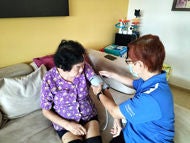- Solstice, a Singapore lung cancer study, uses LDCT scans to detect early-stage lung cancer in at-risk individuals, including non-smokers with a family history.
- The study found cancerous nodules in nine non-smokers, highlighting that X-rays may miss small nodules detected by LDCT scans, which offer a 3D view.
- Early detection through Solstice improves survival rates; Stage 1 lung cancer has a 70% five-year survival rate, while Stage IV is often incurable.
SINGAPORE - Mr Kang Kim Choon, 60, used to get chest X-rays every two to three years to screen for lung cancer after his father was diagnosed with the disease more than a decade ago.
Doing this gave him peace of mind, as his family history puts him at an increased risk of the disease.
But about two years ago, he cancelled his X-ray appointment, after signing up for a lung screening research study by the National Cancer Centre Singapore (NCCS) in early 2023.
As part of the study, Mr Kang went for low-dose computed tomography (LDCT) scans instead.
A cancerous lung nodule, measuring 8mm, was detected in a scan he underwent in 2024. He had no symptoms then.
“I was shocked (to learn) that actually X-rays don’t really pick up nodules of a certain size,” said Mr Kang, who used to work in the IT sector.
Solstice, or Singapore Lung Cancer Screening Through Integrating CT With Other Biomarkers, is the first lung cancer screening research study here that aims to detect lung cancer early in smokers and non-smokers with the use of LDCT scans.
Nodules smaller than 1cm would be hard to pick up in an X-ray, while those around 1cm to 2cm in size might also be missed, depending on their location, said Clinical Assistant Professor Gideon Ooi, a consultant and deputy head of NCCS’ department of oncologic imaging.
“If it’s located farther out in the side of the lung, it’s easier to see. But if it’s very close to the heart, the vessels... can block the nodule.
“So having a CT scan, because it is a 3D view of the chest, allows us to pick up these nodules better.”
Solstice’s larger goal is to understand how to better identify the local population at risk of developing lung cancer. Lung cancers often cause no symptoms until the disease is in an advanced stage, and survival rates are low.
The study aims to recruit 2,000 individuals, between 50 and 80 years old, with a family history of lung cancer, regardless of their smoking history.
It has picked up cancerous lung nodules in nine out of the more than 530 participants screened so far, and all nine, including Mr Kang, are non-smokers. All nine had Stage 1 lung cancer.
Unlike in the West, where the majority of lung cancer cases are attributable to smoking, nearly half of Singapore’s lung cancer patients have never smoked.
Furthermore, in Singapore, there is a disproportionate number of female non-smokers diagnosed with non-small cell lung cancer, which occurs in smokers and non-smokers.
Currently, screening is not recommended here for non-smokers. Singapore’s January 2025 lung cancer screening guidelines recommend LDCT scans for individuals aged 50 to 80 with a 20-pack year smoking history who currently smoke or have quit within the last 15 years.
A 20-pack year – a unit used to measure a person’s lifetime smoking history – is equivalent to smoking one pack of cigarettes a day for 20 years, two packs for 10 years, or half a pack for 40 years.
While the causes of lung cancer in non-smokers are not clear, experts have said that the divergence from Western countries suggests that factors such as exposure to second-hand smoke, air pollution and genetic predispositions in Asian populations might play a dominant role in the prevalence of the disease in the region.

(From left) Clinical Assistant Professor Gideon Ooi, Assistant Professor Cynthia Chia and lung cancer patient Kang Kim Choon.
Mr Kang’s first LDCT scan in April 2023 detected four small nodules in his lungs. A year later, in 2024, a follow-up scan showed that one of the nodules had increased in size, from 5mm to 8mm, but it was too small for biopsy.
He was referred to Assistant Professor Cynthia Chia, a cardiothoracic surgeon from the National Heart Centre Singapore, who recommended surgery to remove the nodule.
The surgery would also remove an estimated 5 per cent of his lung.
“At that point in time, it was a major decision for me: ‘Do I want to monitor it further, or do I want to take it off and do a biopsy then?’
“I was not concerned about myself. I was more concerned about my family,” said Mr Kang. He and his 57-year-old wife have one daughter, 28.
Eventually, he decided on going ahead with the operation, which meant cancelling a hiking trip to the Dolomites mountains in Italy.
Prof Chia said removing 5 per cent of the lung did not have a big impact on Mr Kang.
In fact, Mr Kang returned to his usual exercise routine a month after the surgery, and he has since gone on the hiking trip to Italy.
Patients with normal lung function can typically tolerate the removal of about one-third of one side of their lungs, Prof Chia said.
In Mr Kang’s case, they could conserve more lung because the nodule was very small.
“And because it’s at (a minimally invasive stage), the life expectancy and outcome (for him) is actually almost equivalent to a patient without lung cancer at this point, based on the studies that we do,” she said.
In Singapore, lung cancer is the leading cause of cancer death in men and the third-leading cause of cancer death in women. Among patients, only 16 per cent of men and 24.8 per cent of women are currently diagnosed with Stage 1 lung cancer in Singapore, said NCCS.
When treated early, Stage 1 patients have a five-year survival rate of above 70 per cent, it said.
More than 60 per cent of lung cancer cases in Singapore between 2018 and 2022 were diagnosed at Stage 4 when the disease is no longer curable.
“Solstice helps us screen at-risk healthy people who are asymptomatic,” said Prof Chia.
Participants in the study will also have their blood tested, as the researchers are separately looking to discover biomarkers that are relevant to lung cancer that can one day help with diagnosis.
Prof Chia said the study does not have a fixed end date – it can continue if there is a grant renewal.
Mr Kang is still trying to convince his 55-year-old sibling to do the Solstice lung cancer screening.



















